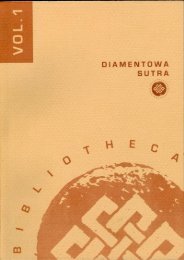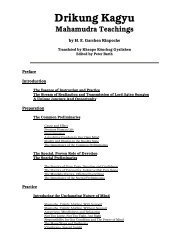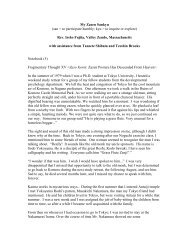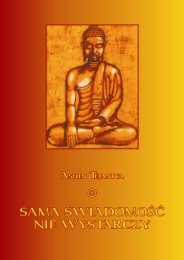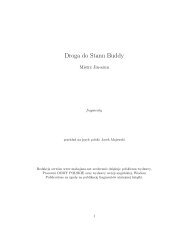3 - Computing in the Humanities and Social Sciences
3 - Computing in the Humanities and Social Sciences
3 - Computing in the Humanities and Social Sciences
You also want an ePaper? Increase the reach of your titles
YUMPU automatically turns print PDFs into web optimized ePapers that Google loves.
hierarchy of differentiated languages accord<strong>in</strong>g to <strong>the</strong> supernatural entity <strong>the</strong>y address<br />
(Tambiah refers to research by Wimal Dissanayake, <strong>in</strong> Tambiah 1985: 20). It would be<br />
well worth pursu<strong>in</strong>g <strong>and</strong> deepen<strong>in</strong>g this l<strong>in</strong>e of <strong>in</strong>vestigation, also <strong>in</strong> o<strong>the</strong>r cultural<br />
contexts. In any case, <strong>in</strong> <strong>the</strong> Japanese arena mantras were usually considered <strong>the</strong><br />
language of <strong>the</strong> Buddha, but it is not clear whe<strong>the</strong>r <strong>the</strong>re were hierarchical differences<br />
among <strong>the</strong>m accord<strong>in</strong>g to <strong>the</strong> level of <strong>the</strong> <strong>in</strong>visible presence <strong>the</strong>y were used to<br />
communicate with. The particular status of mantras <strong>in</strong> East Asia can also be <strong>in</strong>ferred<br />
from <strong>the</strong> symbolism traditionally associated with <strong>the</strong> first Buddhists who brought <strong>the</strong>m<br />
<strong>the</strong>re.<br />
The first people who propagated Buddhism <strong>in</strong> Ch<strong>in</strong>a were called dharmakathika or<br />
dharmabhå√aka (Ch. fashi, Jp. hosshi). Mostly orig<strong>in</strong>ary from Central Asia, one of <strong>the</strong><br />
pr<strong>in</strong>cipal crossroads of <strong>the</strong> ancient world, <strong>the</strong>se Buddhist “missionaries” may have<br />
made a strong impression <strong>in</strong> Ch<strong>in</strong>a (not always <strong>and</strong> not necessarily <strong>in</strong> a positive sense...)<br />
also because of <strong>the</strong>ir mastery of several discipl<strong>in</strong>es, <strong>the</strong>ir memory, <strong>the</strong> ease with which<br />
<strong>the</strong>y h<strong>and</strong>led often abstruse doctr<strong>in</strong>es, <strong>and</strong> <strong>the</strong> eloquence <strong>the</strong>y displayed (Ujike 1984: 77-<br />
81). The oldest Mahayana sutras present fashi as envoys of <strong>the</strong> Buddha, sacred people,<br />
sometimes even as “liv<strong>in</strong>g buddhas” (see for example <strong>the</strong> Lotus Sutra, chapter<br />
“Hosshibon”). Ujike Kakushø has showed that those scriptures were <strong>in</strong>fluential to<br />
establish a close relationship between <strong>the</strong>se preachers <strong>and</strong> mantric expressions. Ujike<br />
even argues that <strong>the</strong> conceptual core of dhåra√∆, as <strong>the</strong>y are understood <strong>in</strong> East Asia,<br />
may have been elaborated precisely by <strong>the</strong> fashi <strong>in</strong> Ch<strong>in</strong>a (Ujike 1984: 80).<br />
In order to protect <strong>the</strong>mselves fashi used charms <strong>and</strong> spells to summon <strong>the</strong> deities.<br />
This practice is described <strong>in</strong> detail <strong>in</strong> <strong>the</strong> Daijikkyø (Ch. Daiji j<strong>in</strong>g fasc. 5, T. 13 nr. 397).<br />
Now, one of <strong>the</strong> possible ways to communicate with <strong>the</strong> deities is to speak <strong>the</strong>ir own<br />
language. In fact, one of <strong>the</strong> skills that were orig<strong>in</strong>ally def<strong>in</strong>ed as dhåra√∆ was <strong>the</strong><br />
capacity to underst<strong>and</strong> <strong>the</strong> tongues of <strong>the</strong> deities (On this po<strong>in</strong>t, see <strong>in</strong> particular Daiji<br />
j<strong>in</strong>g fasc. 2, “Darani jizaiø bosatsu bon”). It was easy, thus, to see mantras as expressions<br />
of a “foreign language”—<strong>the</strong> language of <strong>the</strong> supernatural world. This attitude was<br />
later transmitted to Japan with <strong>the</strong> arrival of Buddhism (Ujike 1984: 86). It is perhaps<br />
worth not<strong>in</strong>g that, <strong>in</strong> <strong>the</strong> collective imag<strong>in</strong>ary of Ch<strong>in</strong>a <strong>and</strong> Japan, foreigners were often<br />
envisioned as not clearly dist<strong>in</strong>ct from be<strong>in</strong>gs from <strong>the</strong> o<strong>the</strong>r world, of which <strong>the</strong>y could<br />
be <strong>the</strong> messengers <strong>and</strong> with which <strong>the</strong>y might communicate. (On <strong>the</strong> ideas concern<strong>in</strong>g<br />
foreigners (ij<strong>in</strong>) <strong>in</strong> traditional Japanese folkloric culture, see for example Komatsu 1985,<br />
1989; Yamaguchi 1975.) In o<strong>the</strong>r words, <strong>the</strong> boundaries between <strong>the</strong> o<strong>the</strong>r world (takai)<br />
16



![Shushogi, Dogen Zenji [PDF] - Mahajana.net](https://img.yumpu.com/50921105/1/190x219/shushogi-dogen-zenji-pdf-mahajananet.jpg?quality=85)


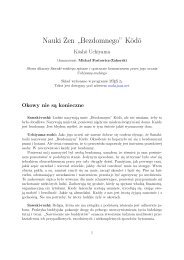

![wywiadu z Murakami Kosho Roshim [PDF] - Buddyzm w Polsce i na ...](https://img.yumpu.com/45809746/1/184x260/wywiadu-z-murakami-kosho-roshim-pdf-buddyzm-w-polsce-i-na-.jpg?quality=85)
